Want to attend my “Hacking Literacy for SLIFE” session at WIDA 2018?
No worries, I have all the resources for you right here. Not everyone can get to these amazing conferences and I feel that it is important to make sure EVERY teacher of ELs has a way to find practical techniques that they can use immediately. Your work is just too important. (SLIFE: Students with Limited or Interrupted Formal Education)
Also! This is a great guide to offering this session at your campus or at a different conference. Spread the love!
Know what else?? Angela Goetz helped me record the session to Facebook LIVE. Here it is:
So I only have about an hour and 15 min with the good folks in Detroit this Wednesday but I will make it worth their while to come to my session. I’m going to squeeze in as many practical techniques as I can. And my goal is for the majority of them to be things we can do in ANY classroom. I want to model those strategies that are critical for our ELs but actually boost the learning of everyone. When you offer PD, do your best to allow the participants to experience these things and have them reflect now and again on how they affect THEIR learning. We could all use reminders!
I am going to start by acknowledging the challenges of SLIFE. The ones on this slide are the big issues I hear most often and they are valid. But I’ll also remind teachers that we have a solution for each of these issues. We just need some practical techniques that work for all kids and also build literacy for our SIFE.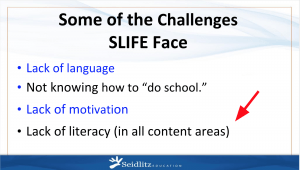
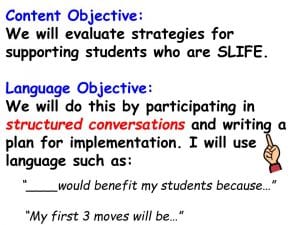 Objectives
Objectives
First I’m going to post my objectives. POST the objectives… not just show them on a slide. I will need to pack some chart paper but this is worth it because those objectives are a visual for students. There are plenty of reasons for doing this and I want to use just a few minutes to explain why and what I’m doing.
When I review the Content and Language Objectives on the wall, I will draw everyone’s attention to each word by pointing to it as I read. I’ll use some gestures of pointing to my chest and my ear while I say “Listen to me first. This is what it sounds like…” Our first Turn & Talk will be about how I opened the session/lesson. I’ll ask participants to consider if they use Exit Tickets and why they would do that. What I’m trying to get to here is that there are several things we can do to build literacy and language in the first few minutes of every class no matter what you teach. And those actions are important for all the students in the class. Here is a great powerpoint by Burleson ISD that explains why you would want to frame your lesson. It’s about helping all students filter information and have a clear learning target for the class. It isn’t hurting anyone that I’m pointing to the words and modeling the pronunciation. In fact, most participants agree that they would benefit from hearing new vocabulary like “Circumference of Circles” or “Homolugus Pairs” before they are expected to use those words in class.
Differentiation
Before we get started and put on our “student” hats, I will ask participants to think about the student(s) they support. It can be one student or some characteristics of the demographic they are most concerned about. If they are in a session supporting SLIFE, they might think about the students who are struggling in mainstream classes. Or they might think about the teachers who teach Newcomer English Development. We need to focus on a specific group for moments of reflection so that we can take reminders or new learning and apply it to our own specific reality.
More on differentiation below.
How to use QSSSA to support ELLs. @MsSalvac #allmodalitiesofcommunication #ELLs #qsssa #edcampsport pic.twitter.com/ybnhlQPide
— Nicole Marino (@missmarino222) July 11, 2017
Questioning Techniques I’ll be Using
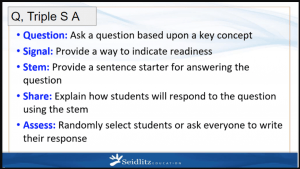 At this point, I will have already modeled one or two QSSSA questions. (You’ll see me do it again at the end of the session) . Seidlitz Education consultants ALWAYS model this questioning strategy. Honestly, I can’t see it modeled too much. As a teacher, I want to internalize this technique and see as many different examples as possible. So the one I will have used for this group might sound something like:
At this point, I will have already modeled one or two QSSSA questions. (You’ll see me do it again at the end of the session) . Seidlitz Education consultants ALWAYS model this questioning strategy. Honestly, I can’t see it modeled too much. As a teacher, I want to internalize this technique and see as many different examples as possible. So the one I will have used for this group might sound something like:
Question: Why would a teacher model the reading of the objectives?
Signal: Show me a thumbs up when you can complete this sentence frame.
Stem: A teacher would model the reading of the objectives because…
Share: Turn to your elbow partner and speak in a complete sentence and the word “model”
Assess: I’ll roll a pair of dice to call on someone.
There are several sheltered strategies wrapped up in the way I am questioning them. I will show this slide and ask them to reflect on them. Am I holding everyone accountable for conversations? Am I offering a low-stress way to produce language? Am I offering wait time with a signal to indicate readiness? Is my question worth asking? If you’d like more learning about this questioning technique, check out this #VirtuEL18 video by me & Tina Beene. We break it down for a social studies classroom but it works in all classrooms.
Later in the session, QSSSA will be a norm and I will try to remember to also use W.I.T. on someone to model how we can up the rigor of our questioning for any particular student. I want to give teachers a way to differentiate in the moment. So at some point, a participant will be called on with the QSSSA technique. They will answer the question and at that point I might ask one of the following:
Why do you think that?
Is there another way to say that?
Tell me more about that.
This usually catches folks off guard and that is okay. We always have a way to get support. I’ll have the “What to Say Instead of IDK” poster somewhere in the room as well.
Instead of IDK Poster
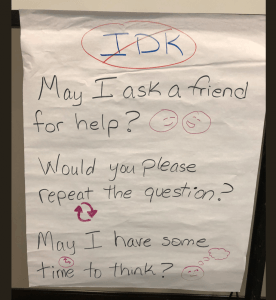 Posters like these are important for every classroom. We could do a whole PD on why that is. But I like to have one up for these short sessions as a visual and also a support to participants.
Posters like these are important for every classroom. We could do a whole PD on why that is. But I like to have one up for these short sessions as a visual and also a support to participants.  It’s just another opportunity to model how our ELs & SLIFE can find success in any classroom with the same supports that are available and important for all students. This one, however, is one that builds survival English right away. These are some of the first sentences we learn in the ESL classroom.
It’s just another opportunity to model how our ELs & SLIFE can find success in any classroom with the same supports that are available and important for all students. This one, however, is one that builds survival English right away. These are some of the first sentences we learn in the ESL classroom.
I love to make this poster with my students so that we can discuss how to use it and why. It also allows me to start with just a few questions and later add more complex responses such as “I don’t know the answer to that question but something I do know is…”
“Elevate the dialog all year!” – John Seidlitz
Ice Breaker
Some folks might skip an ice-breaker in a short session but having students feel comfortable working in your classroom is SO EXTREMELY important that I want to be sure to take a few minutes to do a ‘get to know you’ activity and have participants reflect on it. The sooner your students feel comfortable, the sooner real learning can occur. Look into Stephen Krashen’s Affective Filter Hypothesis for more on that. This is also an opportunity to again think about their own specific demographic of students and how they feel in their classrooms.
Fundamentals of Balanced Literacy
In order to “hack” literacy, we need a basic understanding of Balanced Literacy, in my opinion. That training is something many upper elementary and secondary teachers just don’t receive. Or we get training but the techniques used with 5 year olds just don’t make sense for my middle or high school classroom. 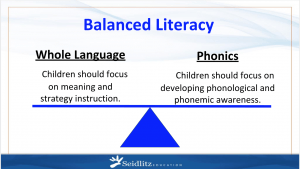
I do an entire day of “Rapid Literacy” training where we go deep into it and also lots of examples of how we can align most of our activities to the principles of Balanced Literacy. In this session, my goal is to give an over-arching idea to participants about best practice (or remind those who have Balanced Lit training) and then help them reflect on everything I’m doing (including the things mentioned above) and how they support literacy development. Decoding skills, specifically.
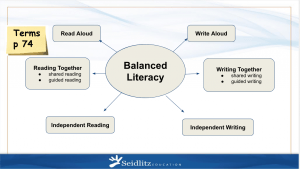 If we are going to hack this, the STUDENTS also need a clear understanding of Balanced Literacy and why we roll out instruction this way. Like our secondary teachers, they don’t need all the details (morphemes, phonemes, phonological vs. phonemic awareness…). But they WILL benefit from understanding what we are doing and why we are doing it. I want to capitalize on the fact that SLIFE are older learners. That means they have more capacity for metacognitive awareness. That is huge when learning to read or learning anything. This is where it is critical that we train our students to understand how a person gains sight words and how a person gains phonological awareness.
If we are going to hack this, the STUDENTS also need a clear understanding of Balanced Literacy and why we roll out instruction this way. Like our secondary teachers, they don’t need all the details (morphemes, phonemes, phonological vs. phonemic awareness…). But they WILL benefit from understanding what we are doing and why we are doing it. I want to capitalize on the fact that SLIFE are older learners. That means they have more capacity for metacognitive awareness. That is huge when learning to read or learning anything. This is where it is critical that we train our students to understand how a person gains sight words and how a person gains phonological awareness.
Sight Words and Phonemic Awareness
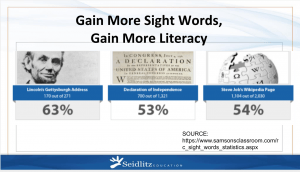
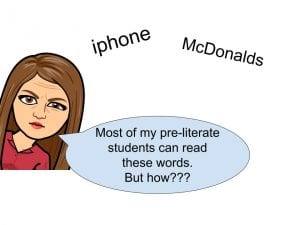 Sight words…they need these! The more sight words they get, the easier it is to decode text. They also need to start to internalize the sounds of our letters and the blends, and the crazy English patterns of spelling. What seems to work well in Kindergarten, spending time with the alphabet and lists of Dolch Sight words, isn’t engaging for older learners. Also, those sounds and words are very confusing for second language learners. But they are incredibly important to build so we will learn them in context! They will learn so many words and sounds of English letters same way they learned the word “McDonalds” or the word “iphone.” They got it with multiple exposures, in context. They start to realize that the “m” makes the /m/ sound because they recognize it from that other word or when they see their friend Maria’s name in print many times.
Sight words…they need these! The more sight words they get, the easier it is to decode text. They also need to start to internalize the sounds of our letters and the blends, and the crazy English patterns of spelling. What seems to work well in Kindergarten, spending time with the alphabet and lists of Dolch Sight words, isn’t engaging for older learners. Also, those sounds and words are very confusing for second language learners. But they are incredibly important to build so we will learn them in context! They will learn so many words and sounds of English letters same way they learned the word “McDonalds” or the word “iphone.” They got it with multiple exposures, in context. They start to realize that the “m” makes the /m/ sound because they recognize it from that other word or when they see their friend Maria’s name in print many times.
Please remember that these kids know more English EVERY DAY. So the difficulty of all of this is lessened the more we do it.
One block down, 2 more to go! Easier than I thought! Kids loved it!@MsSalvac #Watchmmjhlead #mmjhpln #Katyisdool #Katy2ndaryESL pic.twitter.com/FVrfAyacDX
— Edna Martinez (@EMartinezMMJH) October 16, 2017
Co-Creating Text
 I will model Language Experience Approach or at least a few sentences so participants can see how I create a piece of mentor text with my class. If you want more on that, check out this post and video where I am doing it with my classroom and also modeling QSSSA. It’s a great video because there is some bad teaching in there that I point out. (Super important to reflect with our specific goals for students in mind.)
I will model Language Experience Approach or at least a few sentences so participants can see how I create a piece of mentor text with my class. If you want more on that, check out this post and video where I am doing it with my classroom and also modeling QSSSA. It’s a great video because there is some bad teaching in there that I point out. (Super important to reflect with our specific goals for students in mind.)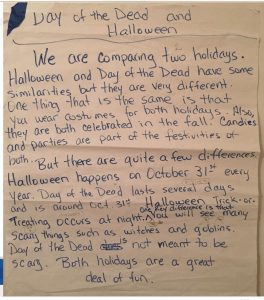
Back to Differentiation
One of my main forms of differentiation in my classroom is the reflection piece for students. Each of my learners are at a different place in their learning for content, language and background. I am constantly reminding students of their role in the acquisition of language and literacy.
If they JUST arrived, their main focus should be on getting the ‘gist’ and staying attentive when we are speaking in English. They should know that their will be stops & checks for understanding with native language if need be, but their main goal is to attend to print and listening for phonemic awareness (sounds of the letters) and sight word recognition (building more automaticity with high-frequency words). If they just stay attentive, they will start to internalize all of it with multiple exposures in context that allow them time to think and have conversations about their learning.
The long-term language learner should realize that their role is to continue to build sight words and phonemic awareness but they are also to analyze the structures of the language and to be on the look out for elevated dialog. I will use words & phrases such as “significant” and “in a similar fashion” in my language objectives and in my co-created text. I will quickly point out their meaning but the walls are my co-teacher for much of the year.
This is very important. It is critical that the students realize their role and also for our content teachers to be aware of all of this. That way the math/science/social studies teachers can do simple things like reading the objectives aloud and pointing to the words. The student knows why they are doing it and the teacher can feel good about moving literacy forward.
Tracking Print
I am excited to use Tan Huynh’s forward to model tracking print and also an activity where I read aloud and stop for students to say the next word. It is a compelling piece of writing and you have it here on the handout. I will model a few other ways teachers can have students tracking print during this session. Using Kahoot, News In Levels, My cellphone to record myself reading aloud… there are many ways to read WITH students that don’t seem “baby-ish”
Many of those techniques are on this website. In fact, here are the notes from last year’s WIDA conference.
Here is the handout.
 Loading...
Loading...
My hope is to open the session with this video. I think it is the perfect example of what is possible when you partner with your SLIFE students and with other EL teachers. (thank you Emily Francis!)
I’ll also be sharing some books by Saddleback Educational Publishing. They are like GOLD! They’re at booth 218 if you are at the conference. Otherwise find them at https://about.myon.com/book-publisher/saddleback-educational-publishing
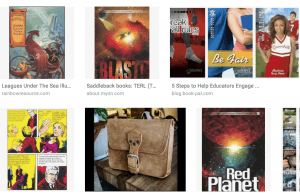
If you are going to do a session with your faculty, I would also suggest this video by Valentina Gonzales. In 4 minutes, Valentina Gonzalez shows the power of Comprehensible Input.
Thanks to everyone who shares information with me like what you see above. If you have any questions or input, please just reach out. I’d love to hear from you!
Hugs!
Carol
PS: What are the needs of your teachers? We can come to your district and help you inspire your learners and your teachers. Just reach out for a free consultation. I’m at carol.salva@johnseidlitz.com or on Twitter at @MsSalvaC.
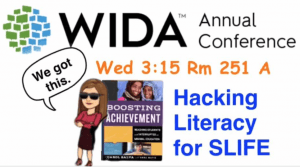
Is your presentation available for download? If so, I don’t see it. Thanks in advance.
Hi Eileen! Guess what! I didn’t use a powerpoint. All I used was this blog post. I just scrolled through it and clicked on the images so they would display full screen. I did this intentionally so that anyone reading or watching it could do the same. However, you can always take screenshots of the slides and paste those into a powerpoint or google slides to build a traditional presentation. One idea is to also give your participants this blogpost link (bit.ly/SalvaWIDA) and let them follow along and have all the links that are embedded. I hope this is helpful!